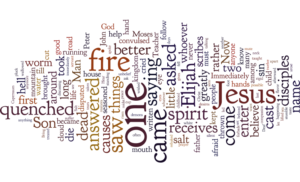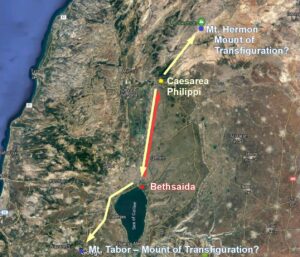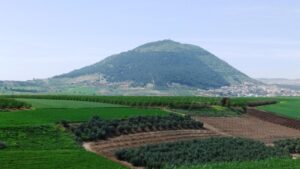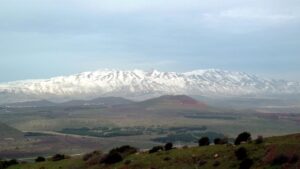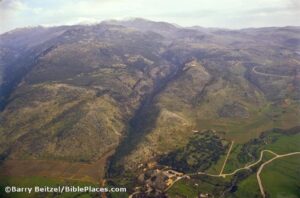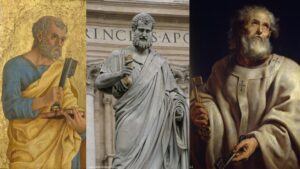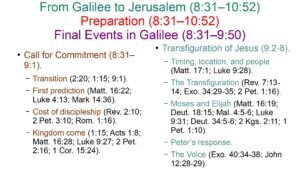Jesus from Galilee to Jerusalem
Mark 8:31–10:52
Preparation
First Prediction of Death and Resurrection (8:31).
The Kingdom is Near (1:15; 9:1)
Final Events in Galilee (8:31–9:50).
Call for Commitment (8:31–9:1). Table of Interpretations of Mark 9:1.
Transfiguration (9:2-8).
The event of the Transfiguration takes place after six days when Jesus spoke to the people and His disciples, possibly in Caesarea Philippi.
Matthew also says after six days (Matt. 17:1), but Luke says about eight days after (Luke 9:28).
Is there a contradiction? No, eight days is after six days, and Luke didn’t say exactly eight days, but about eight days.
It’s interesting Mark makes a time statement like this—he normally does not, so why here? It gives us a sense as to immediacy of how soon after the confession this occurs, as if confirming that the confession was true.
Note the three individuals who Jesus calls to witness the event: Peter, James, and John, the inner inner circle.

Later, Jesus would tell these men to be silent about this event until after the resurrection—a time statement on the Messianic secret. Perhaps it’s easier for three men to keep a secret instead of twelve, especially when one would become a traitor.
The location is up for much speculation, but the Scripture simply says a “high mountain.”
The traditional cite is Mt. Tabor, and you may have figured out by now, I tend to go with the more traditional location for particular events in Scripture… but not this time.
Origen from the 3rd century is the first written statement indicating where this event might have occurred.
If so, the events we read about in between the confession and this point could have occurred anywhere

Mt. Tabor along the path there, but it does not take six days to get to Mt. Tabor from Caeserea Philippi (only about two days). So they could have taken their time getting there.
Others have suggested that Mt. Tabor, at only 1886 ft, does not qualify as a “high mountain.” Only nearby Mt. Hermon qualifies, at 9232 ft, the highest peak in the region.
Also, since they were already in Caeserea Philippi, it would make sense for them to wait there for a few days and head up the mountain for this event.
For those reasons, I think it likely that Mt. Hermon is, indeed, the Mount of Transfiguration.
The Transfiguration.
Then he was transfigured before them.
The Greek word may seem familiar: μεταμορφόω – metamorphosis, to change or alter form, to transform.
So He was transformed before them, undergone some kind of metamorphosis.
This was not mythological metamorphosis, where one turns into a plant, animal, or stone; nor was this a natural metamorphosis, where a caterpillar turns into a butterfly.
The text indicates that what changed about Him was His clothes—bright, shining, the whitest white you’ve ever seen.
Perhaps this is why all the depictions of Jesus have Him in white clothes?
White clothing have become a symbol of righteousness and purity, of heaven and its glory (Rev. 7:13-14).
On top of that, the other accounts indicate that His face was changed, too, not unlike Moses’ face when he came down Mt. Sinai (Exo. 34:29-35).
Peter even described it much later, saying he was an eyewitness of “His majesty” (2 Pet. 1:16).
And who should appear but …
Moses and Elijah.
One thing that I always wondered—without photos, how did Peter, James, and John recognize Moses and Elijah?
Even with photos, particularly older photos, I don’t know that I’d recognize certain people, let alone other depictions.
Here is an example of icons and sculptures from denominations that bel2ieve they should be used.
You see, if one notices certain things to look for they might be able to tell who someone is.
**Who is this?** Well, the first thing we might notice is that this person is holding a set of keys. Who in
 Scripture is said to have had keys? Peter! Jesus says he would given the keys to the kingdom (Matt. 16:19). So he is often depicted as having keys.
Scripture is said to have had keys? Peter! Jesus says he would given the keys to the kingdom (Matt. 16:19). So he is often depicted as having keys.While they didn’t have a lot of works of art back then of these great men of the Bible, they did have descriptions of them in Scripture. No doubt there was some outward indication of who these men were so that the trio could recognize them.
Why them? Lots of different explanations present themselves.
The most obvious is that they represent the Law and the Prophets. Moses was the great lawgiver, the one who brought God’s Law down the mountain. Elijah, while not a writing prophet, was considered the quintessential prophet at that time, representative of all the prophets, writing and non-writing alike. This point is buttressed by what the voice from heaven says later.
Another possibility is that both these men had encountered God on Mt. Sinai—Moses received the Law, and Elijah heard Him in a still, small voice (1 Kgs. 19).
Another is the eschatological expectations—a Prophet like Moses would come (Deut. 18:15) and Elijah
 would return (Mal. 4:5-6) – we’ll note the trio was reminded of Elijah’s return since they ask questions about it later.
would return (Mal. 4:5-6) – we’ll note the trio was reminded of Elijah’s return since they ask questions about it later.I tend to think it was for all these reasons these two men appeared.
In Luke, he records that they were discussing His decease (Luke 9:31).
Both of these men experienced unusual ends. Moses died alone… or perhaps with God. Whatever the case, no one saw his body, and no one buried him. God took care of that (Deut. 34:5-6). Elijah did not die, but was carried up in a fiery chariot (2 Kgs 2:11).
Perhaps they were offering words of comfort. Perhaps they were excited, for what was coming were things concerning which “the prophets have inquired and searched carefully” (1 Pet. 1:10). Who knows?
